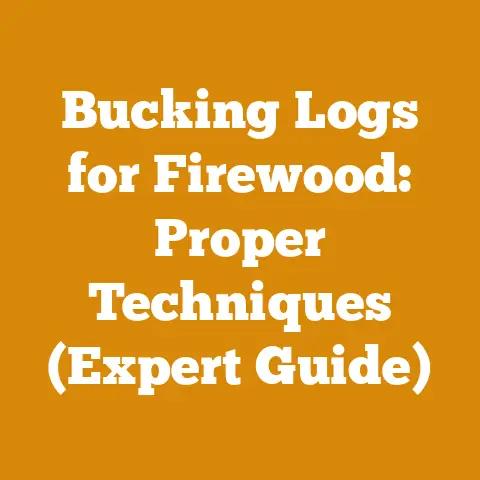Basement Wood Burning Stove Efficiency (7 Pro Tips for Optimal Heat)
Are you dreaming of a cozy, wood-heated basement but dreading sky-high heating bills? Let’s turn that dream into a reality without burning a hole in your wallet!
Basement Wood Burning Stove Efficiency: 7 Pro Tips for Optimal Heat
For years, I’ve been deeply involved in the world of wood processing and heating. From felling trees in the crisp autumn air to splitting logs on a frosty winter morning, I’ve learned firsthand the ins and outs of efficient wood burning. One thing I’ve seen time and again is that a wood-burning stove in the basement can be a fantastic way to supplement your heating, but only if done right. It’s not just about throwing logs into a box; it’s about understanding airflow, wood selection, and stove placement.
1. Right-Sizing Your Stove: More Isn’t Always Better
Choosing the right size stove is paramount. It’s a common misconception that a larger stove is always better. In fact, an oversized stove will often smolder, producing more smoke and creosote, and less heat. This is because it won’t burn hot enough to fully combust the wood.
Sizing Considerations:
- Square Footage: A general rule of thumb is that a stove should be sized to heat the square footage of the area you intend to heat. For a basement, consider the total square footage, but also factor in insulation, ceiling height, and the number of windows. A well-insulated 1,000 sq ft basement will require a smaller stove than a poorly insulated one.
- BTU Output: Stoves are rated in British Thermal Units (BTUs). This rating tells you how much heat the stove can produce per hour. A range of 30,000 to 60,000 BTU is common for basement stoves, but the exact figure depends on your specific needs.
- Climate: Consider your local climate. In colder regions, you’ll obviously need a stove with a higher BTU output.
- Stove Efficiency Rating: Look for stoves with a high efficiency rating. An EPA-certified stove will burn cleaner and more efficiently than an older, non-certified model. EPA-certified stoves typically have an efficiency rating of 70% or higher.
Cost Implications:
The cost of a wood-burning stove can vary widely, from a few hundred dollars for a basic model to several thousand for a high-efficiency, catalytic stove. Here’s a breakdown:
- Basic Stove (Non-EPA Certified): \$300 – \$800
- EPA-Certified Stove (Non-Catalytic): \$800 – \$2,000
- EPA-Certified Stove (Catalytic): \$1,500 – \$3,500+
Installation costs can also vary depending on whether you’re installing the stove yourself or hiring a professional. Professional installation can cost anywhere from \$500 to \$2,000, including chimney installation and permits. I always recommend getting multiple quotes and checking references before hiring an installer.
Personal Experience:
I once helped a friend install an oversized stove in his basement. He thought bigger was better, but the stove ended up smoking excessively and producing very little usable heat. After some research and a lot of frustration, we replaced it with a smaller, EPA-certified model. The difference was night and day. The new stove burned cleanly, produced much more heat, and used less wood.
Data and Statistics:
According to the EPA, wood stoves manufactured before 1988 are significantly less efficient than modern EPA-certified stoves. These older stoves can release up to 50 grams of particulate matter per hour, while EPA-certified stoves release less than 4.5 grams. This translates to significant fuel savings and reduced air pollution.
Actionable Steps:
- Measure your basement square footage.
- Assess your basement’s insulation.
- Consult with a stove dealer to determine the appropriate BTU output for your needs.
- Prioritize EPA-certified stoves for optimal efficiency and reduced emissions.
- Get multiple installation quotes before making a decision.
2. Chimney Placement and Draft: The Key to Efficient Combustion
The chimney is the lifeline of your wood-burning stove. Proper chimney placement and draft are crucial for efficient combustion and safe operation. A poorly designed or installed chimney can lead to smoke backdrafts, creosote buildup, and even chimney fires.
Chimney Considerations:
- Height: The chimney should extend at least three feet above the highest point of the roof within a 10-foot radius. This ensures adequate draft and prevents downdrafts caused by wind.
- Placement: The chimney should be located in a position that minimizes horizontal runs. Long horizontal runs can reduce draft and increase creosote buildup. Ideally, the chimney should run straight up from the stove.
- Insulation: Insulating the chimney can improve draft and reduce creosote buildup. This is particularly important for exterior chimneys, which are more susceptible to temperature fluctuations.
- Diameter: The chimney diameter should match the stove’s flue outlet. An undersized chimney can restrict airflow, while an oversized chimney can cool the exhaust gases, leading to creosote buildup.
- Material: Chimneys can be made of various materials, including masonry, metal, and ceramic. Metal chimneys are generally easier to install and less expensive than masonry chimneys. However, masonry chimneys can provide better insulation and a more traditional look.
Understanding Draft:
Draft is the upward flow of air through the chimney. It’s created by the difference in temperature between the hot exhaust gases inside the chimney and the cooler air outside. A strong draft is essential for efficient combustion and preventing smoke from entering the room.
Factors that can affect draft include:
- Chimney height: Taller chimneys generally have a stronger draft.
- Chimney diameter: The correct diameter is crucial, as previously mentioned.
- Outdoor temperature: Cold weather generally improves draft.
- Wind: Wind can either enhance or impede draft, depending on its direction.
- Obstructions: Obstructions such as bird nests or creosote buildup can reduce draft.
Cost Implications:
Chimney installation can be a significant expense. Here’s a breakdown of potential costs:
- Chimney Liner (Stainless Steel): \$500 – \$2,000 (depending on length and diameter)
- Chimney Pipe (Double-Wall): \$100 – \$300 per section
- Chimney Cap: \$50 – \$200
- Professional Installation: \$500 – \$1,500+
The cost of a new chimney can range from \$2,000 to \$10,000+, depending on the materials used and the complexity of the installation.
Personal Experience:
I once helped a friend troubleshoot a smoky stove. After inspecting the chimney, we discovered a bird’s nest blocking the flue. Removing the nest immediately improved the draft and eliminated the smoke problem. This experience taught me the importance of regular chimney inspections.
Data and Statistics:
According to the National Fire Protection Association (NFPA), chimney fires are a leading cause of residential fires. Regular chimney inspections and cleaning can significantly reduce the risk of a chimney fire. The NFPA recommends having your chimney inspected and cleaned annually by a qualified professional.
Actionable Steps:
- Ensure your chimney meets local building codes and regulations.
- Have your chimney inspected annually by a qualified professional.
- Clean your chimney regularly to remove creosote buildup.
- Consider insulating your chimney to improve draft and reduce creosote buildup.
- Install a chimney cap to prevent rain, snow, and debris from entering the chimney.
3. Airflow Optimization: The Breath of Life for Your Fire
Proper airflow is essential for efficient combustion. Wood needs oxygen to burn, and the more oxygen it gets, the hotter and cleaner it will burn. Optimizing airflow involves controlling the amount of air entering the stove and directing it to the right places.
Airflow Controls:
Most wood stoves have primary and secondary air controls.
- Primary Air: Controls the amount of air entering the stove at the bottom. This air is used to start the fire and maintain a high burn rate.
- Secondary Air: Introduces air into the firebox above the wood. This air helps to burn the gases released by the wood, reducing smoke and increasing efficiency.
Optimizing Airflow:
- Start with the air controls fully open. This will help to establish a strong fire.
- Once the fire is burning well, gradually close the primary air control. This will reduce the burn rate and conserve fuel.
- Adjust the secondary air control to minimize smoke. The goal is to have a clean-burning fire with minimal visible smoke.
- Experiment with different air control settings to find the optimal settings for your stove and firewood.
Air Leaks:
Air leaks can negatively impact airflow and reduce efficiency. Common sources of air leaks include:
- Door gaskets: Worn or damaged door gaskets can allow air to leak into the stove, disrupting the airflow.
- Ash pan: A poorly sealed ash pan can also allow air to leak into the stove.
- Chimney connections: Loose or corroded chimney connections can allow air to leak in.
Cost Implications:
Maintaining proper airflow doesn’t typically involve significant costs, but replacing worn parts can add up.
- Door Gasket: \$10 – \$30
- Ash Pan: \$50 – \$150
- Chimney Connector Pipe: \$20 – \$50 per section
Personal Experience:
I once struggled to get a clean burn in my stove. After inspecting the door gasket, I discovered that it was cracked and brittle. Replacing the gasket made a huge difference. The stove burned much cleaner and produced more heat.
Data and Statistics:
Studies have shown that optimizing airflow can increase stove efficiency by as much as 20%. This translates to significant fuel savings and reduced emissions.
Actionable Steps:
- Familiarize yourself with your stove’s air controls.
- Experiment with different air control settings to find the optimal settings for your stove and firewood.
- Inspect your stove for air leaks and repair them as needed.
- Clean your stove regularly to remove ash and debris that can obstruct airflow.
- Ensure your firewood is properly seasoned to promote efficient combustion.
4. Wood Selection and Seasoning: The Fuel That Feeds Your Fire
The type and quality of wood you burn can have a significant impact on stove efficiency. Seasoned hardwood is the ideal fuel for a wood-burning stove.
Wood Types:
- Hardwoods: Hardwoods like oak, maple, ash, and beech are denser than softwoods and contain more energy per unit volume. They burn longer and produce more heat.
- Softwoods: Softwoods like pine, fir, and spruce are less dense than hardwoods and contain less energy. They burn faster and produce more smoke.
Seasoning:
Seasoning is the process of drying wood to reduce its moisture content. Green wood can contain up to 50% moisture, while seasoned wood typically has a moisture content of 20% or less. Burning green wood is inefficient because a significant portion of the heat is used to evaporate the water in the wood. This results in less heat for your home and more smoke and creosote.
Seasoning Tips:
- Split the wood: Splitting the wood increases the surface area exposed to the air, speeding up the drying process.
- Stack the wood: Stack the wood in a single row, with space between the pieces for air circulation.
- Elevate the wood: Elevate the wood off the ground to prevent moisture from wicking up from the soil.
- Cover the wood: Cover the top of the woodpile to protect it from rain and snow, but leave the sides open for ventilation.
- Allow ample time: Seasoning typically takes 6-12 months, depending on the type of wood and the climate.
Moisture Meters:
A moisture meter is a useful tool for determining the moisture content of your firewood. Aim for a moisture content of 20% or less for optimal burning.
Cost Implications:
The cost of firewood can vary widely depending on the type of wood, the location, and the season.
- Cord of Hardwood (Seasoned): \$200 – \$400+
- Cord of Softwood (Seasoned): \$150 – \$300+
Seasoning your own firewood can save you money, but it requires time and effort.
Personal Experience:
I once burned a load of green wood in my stove. The fire was difficult to start, produced a lot of smoke, and barely generated any heat. After switching to seasoned hardwood, the difference was remarkable. The fire burned cleanly, produced plenty of heat, and required less wood.
Data and Statistics:
Studies have shown that burning seasoned wood can increase stove efficiency by as much as 30%. This translates to significant fuel savings and reduced emissions.
Actionable Steps:
- Choose seasoned hardwood for optimal burning.
- Season your own firewood to save money.
- Use a moisture meter to ensure your firewood is properly seasoned.
- Store your firewood in a dry, well-ventilated area.
- Avoid burning green wood, as it is inefficient and produces more smoke.
5. Stove Placement and Heat Distribution: Where You Put It Matters
The placement of your wood-burning stove in the basement is crucial for maximizing heat distribution and efficiency. A strategically placed stove can effectively heat the entire basement and even contribute to heating the upper floors of your home.
Placement Considerations:
- Central Location: Ideally, the stove should be placed in a central location in the basement. This will allow the heat to radiate evenly throughout the space.
- Open Space: Avoid placing the stove in a small, enclosed room. The heat will become trapped and won’t be able to circulate effectively.
- Proximity to Stairs: If you want to heat the upper floors of your home, place the stove near the stairs. The rising heat will naturally flow upwards.
- Clearance to Combustibles: Maintain adequate clearance to combustible materials such as walls, furniture, and curtains. Consult your stove’s manual for specific clearance requirements.
- Floor Protection: Protect the floor beneath the stove with a non-combustible material such as brick, stone, or metal.
Heat Distribution Strategies:
- Fans: Use fans to circulate the heat throughout the basement and to the upper floors. A ceiling fan can help to push the warm air downwards, while a floor fan can help to move the heat to other areas of the basement.
- Open Doors: Keep doors open to allow the heat to flow freely between rooms.
- Insulation: Insulating your basement walls and ceiling can help to retain heat and reduce energy loss.
- Ductwork: If your basement has ductwork, consider installing a register near the stove to allow the heat to be distributed throughout the house via the central heating system. (Consult a professional for this)
Cost Implications:
Improving heat distribution can involve some upfront costs, but the long-term energy savings can outweigh the initial investment.
- Fans: \$20 – \$100+
- Insulation: \$1 – \$3 per square foot
- Ductwork Modifications: \$100 – \$500+
Personal Experience:
I once helped a friend rearrange his basement to improve heat distribution from his wood-burning stove. We moved the stove to a more central location and installed a ceiling fan to circulate the air. The difference was significant. The basement was much warmer and more comfortable, and he was able to reduce his reliance on his central heating system.
Data and Statistics:
Studies have shown that proper stove placement and heat distribution can increase overall heating efficiency by as much as 15%. This can translate to significant energy savings over the long term.
Actionable Steps:
- Choose a central location for your stove with adequate clearance to combustibles.
- Use fans to circulate the heat throughout the basement and to the upper floors.
- Keep doors open to allow the heat to flow freely between rooms.
- Insulate your basement walls and ceiling to retain heat and reduce energy loss.
- Consider modifying your ductwork to distribute the heat throughout the house. (Consult a professional)
6. Regular Maintenance and Cleaning: A Stitch in Time Saves Nine
Regular maintenance and cleaning are essential for maintaining the efficiency and safety of your wood-burning stove. Neglecting maintenance can lead to reduced efficiency, increased creosote buildup, and even chimney fires.
Maintenance Tasks:
- Chimney Inspection and Cleaning: Have your chimney inspected and cleaned annually by a qualified professional. This will remove creosote buildup and prevent chimney fires.
- Stove Cleaning: Clean your stove regularly to remove ash and debris. This will improve airflow and prevent corrosion.
- Gasket Inspection and Replacement: Inspect the door gasket and ash pan gasket regularly and replace them if they are worn or damaged.
- Baffle Inspection: If your stove has a baffle, inspect it regularly for damage or deterioration. A damaged baffle can reduce efficiency and increase emissions.
- Firebrick Inspection: Inspect the firebricks lining the firebox for cracks or damage. Replace any damaged firebricks to protect the stove’s metal shell.
Cleaning Tools:
- Chimney Brush: Used to clean the chimney flue.
- Ash Shovel: Used to remove ash from the stove.
- Wire Brush: Used to clean the stove’s interior surfaces.
- Vacuum Cleaner: Used to remove loose ash and debris.
Cost Implications:
Regular maintenance can involve some upfront costs, but it can save you money in the long run by preventing costly repairs and improving efficiency.
- Chimney Inspection and Cleaning: \$100 – \$300+
- Door Gasket: \$10 – \$30
- Firebrick: \$5 – \$20 per brick
- Baffle Replacement: \$50 – \$200+
Personal Experience:
I once neglected to clean my chimney for several years. When I finally had it inspected, the chimney sweep found a significant amount of creosote buildup. He warned me that I was lucky to have avoided a chimney fire. This experience taught me the importance of regular chimney maintenance.
Data and Statistics:
The NFPA recommends having your chimney inspected and cleaned annually by a qualified professional. Regular chimney maintenance can significantly reduce the risk of a chimney fire.
Actionable Steps:
- Have your chimney inspected and cleaned annually by a qualified professional.
- Clean your stove regularly to remove ash and debris.
- Inspect and replace worn or damaged gaskets.
- Inspect the baffle and firebricks for damage and replace them as needed.
- Follow the manufacturer’s recommendations for maintenance and cleaning.
7. Optimizing Burn Techniques: Mastering the Art of Fire
Even with the best stove, chimney, and firewood, your burning technique can significantly impact efficiency. Mastering the art of fire involves understanding how to load the stove, control the airflow, and maintain a clean burn.
Loading Techniques:
- Top-Down Burning: This technique involves loading the stove with larger pieces of wood at the bottom and smaller pieces of kindling at the top. The fire burns downwards, producing less smoke and more heat.
- Crib Loading: This technique involves stacking the wood in a crisscross pattern, creating a “crib” of wood. This allows for good airflow and even burning.
- East-West Loading: This technique involves loading the wood horizontally, with the ends of the logs facing the door. This allows for longer burn times.
Airflow Control:
- Start with the air controls fully open to establish a strong fire.
- Once the fire is burning well, gradually close the primary air control to reduce the burn rate and conserve fuel.
- Adjust the secondary air control to minimize smoke. The goal is to have a clean-burning fire with minimal visible smoke.
Burn Rate Management:
- Adding small pieces of wood frequently will result in a hotter, cleaner burn.
- Adding large pieces of wood less frequently will result in a longer, slower burn.
- Adjust the airflow controls to maintain the desired burn rate.
Avoiding Smoldering:
- Smoldering fires produce more smoke and creosote and less heat.
- To avoid smoldering, ensure that the fire is getting enough air and that the wood is properly seasoned.
- If the fire is smoldering, open the air controls and add small pieces of wood to increase the burn rate.
Cost Implications:
Optimizing burn techniques doesn’t involve any direct costs, but it can save you money by reducing fuel consumption and improving efficiency.
Personal Experience:
I used to load my stove with large pieces of wood and let it smolder overnight. This resulted in a lot of smoke and very little heat. After learning about top-down burning, I switched to this technique. The difference was remarkable. The fire burned cleaner, produced more heat, and used less wood.
Data and Statistics:
Studies have shown that optimizing burn techniques can increase stove efficiency by as much as 10%. This translates to significant fuel savings over the heating season.
Actionable Steps:
- Experiment with different loading techniques to find the one that works best for your stove and firewood.
- Control the airflow to maintain a clean burn and the desired burn rate.
- Avoid smoldering fires, as they are inefficient and produce more smoke.
- Learn from experienced wood burners and share your knowledge with others.
- Continuously refine your burning techniques to maximize efficiency and minimize emissions.
Final Thoughts: Embrace the Warmth and Efficiency
By implementing these seven pro tips, you can transform your basement wood-burning stove into a highly efficient and cost-effective heating solution. Remember, it’s not just about burning wood; it’s about understanding the science and art of fire. By choosing the right stove, optimizing airflow, selecting the best firewood, and mastering burn techniques, you can enjoy the warmth and comfort of a wood-heated basement without breaking the bank. So, go forth, embrace the fire, and stay warm! And don’t forget, wood processing and firewood preparation is an ongoing learning experience. Always be open to new techniques and information to improve your efficiency and reduce your costs.






